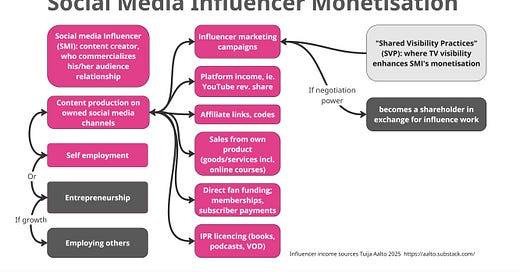Social Media Influencers Monetise Through Multiple Income Streams
SMI's livelihood likely originates from several sources
Commercial collaborations, that is, influencer marketing, is the most typical if not the most important income source for social media content creators in Finland, based on the research interviews that I conducted in connection with my doctoral research during 2022-2023 with influencer agency executives as well as influencers themselves in Finland.
Influencer marketing (IM) is therefore listed on top of the many revenue streams a SMI might consider, in the second column of the graph above. The figure depicts various other monetisation options SMIs may tap into from platform-originated (such as YouTube’s) advertising revenues to direct fan income either enabled by a third party service such as Patreon or various forms of fan funding via platforms (such as paid channel memberships, subscriptions, or other payments).
By combining several income sources a social media content creator may be able to make a living as self-employed SMI, or as an entrepreneur. If willing to grow his or her media business, the creator-entrepreneur could then employ others. An other avenue for owning equity might be becoming a company shareholder, by accepting shares instead of cash remuneration for influencer services.
In the hybrid media environment, where ideas are amplified flowing between traditional media logics, social media logics, and, indeed, influencer logics, an important consideration is TV visibility. I have written about shared visibility practices, or SVP, in another post.
I’ve monitored the influencer industry and creator industry developments for more than a decade as part of my various roles within the Finnish Broadcasting Company Yle.
Of course, Finland's influencer industry is modest on the scale of English-speaking markets.
Still, it is interesting to consider a recent case study provided by Linus Media Group (see video on the Linus Tech Tips (LTT) channel). Here, we see an ~100-million-dollar-sized media company, “far beyond the “solo creator + AdSense” model”, as summarized by Ian Shepherd for Forbes: Linus has built an independent media company with owned intellectual property (IP), a direct-to-consumer merch line (Creator Warehouse / LTTStore.com), a proprietary subscription platform (Floatplane) and multi-channel ad revenue, enabled by a highly engaged audience community.
In Finland, one social media video entertainment production company to watch would be Roni Bäck’s Back Media Oy.






Interesting! Speaking in my capacity as someone who has worked with and represented influencers for nearly a decade, I unfortunately quite often find that traditional media (in relation to what you describe as "Shared Visibility Practices") tend to overestimate their own significance when it comes to impact and relevance.
They’re stuck in an old-fashioned, traditional mindset where everyone watches TV, listens to the radio, or reads the newspaper, even though, especially among young people, media habits are far more complex than that. I wonder if this might create a false sense of security in working with someone who appears to be "everywhere," when in fact, "everywhere" isn’t really the case. What does the research say about this?
Keep up the great and important work!